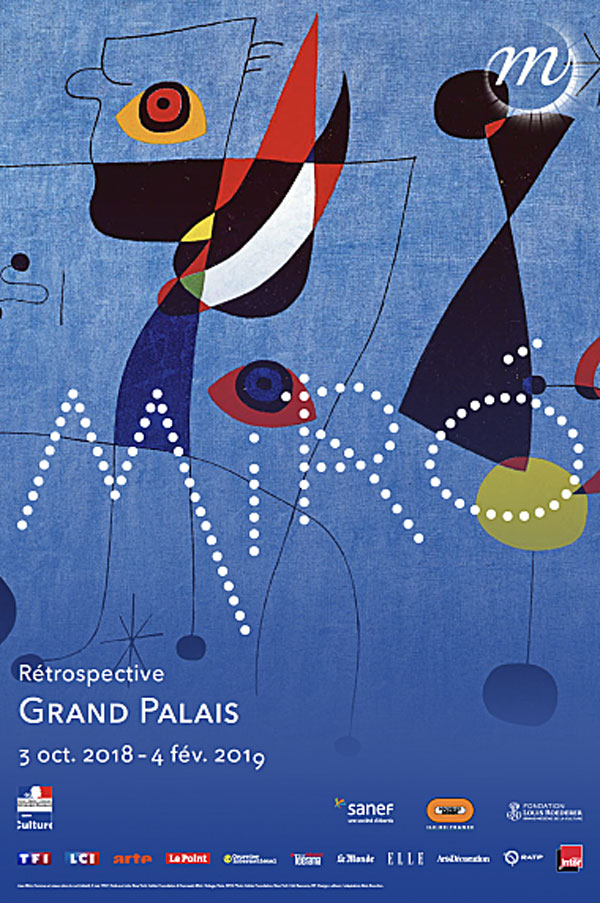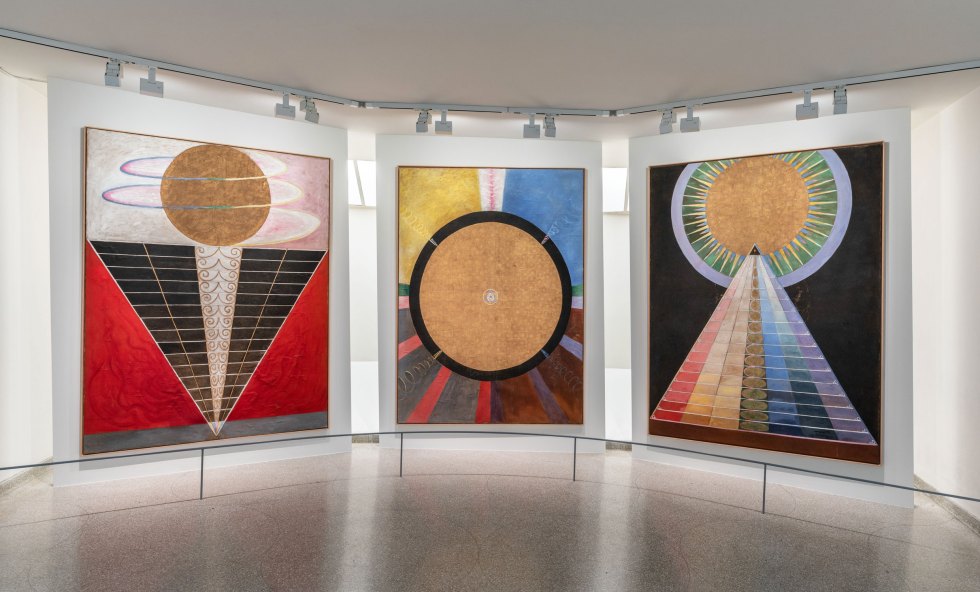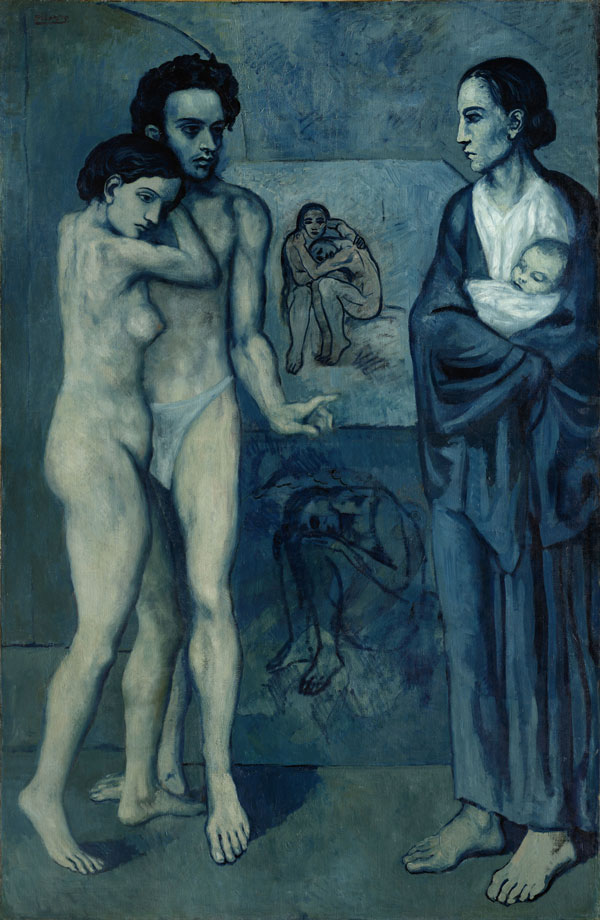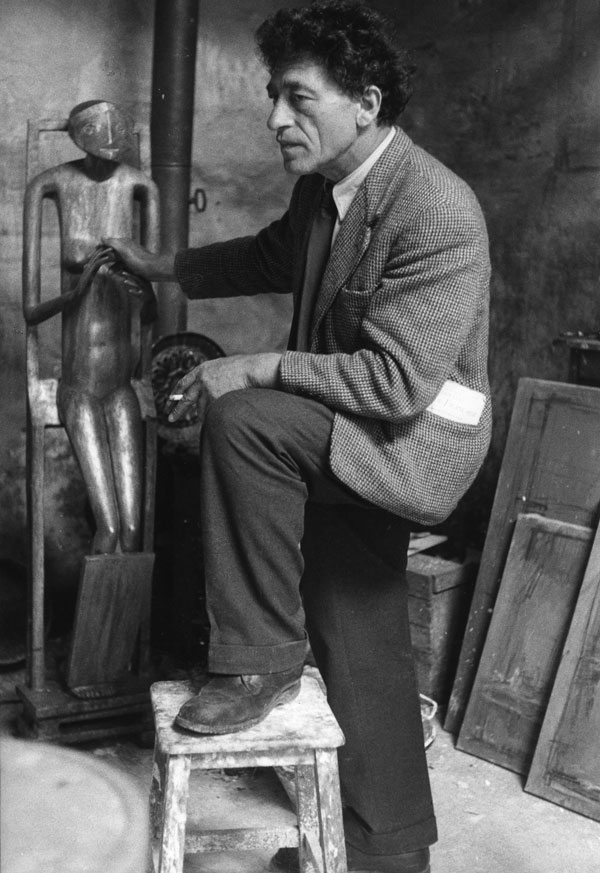|
Cette exposition est organisée par la Réunion des musées nationaux-Grand Palais. This retrospective on the great Catalan master Joan Miró (1893-1983) brings together nearly 150 key pieces to give this unique and important body of work its rightful place in modernity. This exhibition takes place forty-four years after the one organised by Jean Leymarie and Jacques Dupin at the same venue in 1974. Exceptional loans from some of the most important museums in Europe, America and across the globe, as well as major private collections, place the emphasis on the pivotal periods for Miró, who once declared: “People will understand more and more that I opened the doors to another future, that runs against all falsehood, all fanaticism.” The work of this exceptional artist shaped art throughout the 20th century, radiating its power and poetry for almost seven decades with unrivalled generosity and originality. |
 |
Solomon R. Guggenheim Museum Hilma af Klint Paintings for the Future
|
Solomon R. Guggenheim Museum (NEW YORK, NY— November 20, 2018)—The Solomon R. Guggenheim Museum will extend its hours until 8 pm during the holiday season, providing an additional opportunity for audiences to experience exhibitions on view, such as the groundbreaking Hilma af Klint: Paintings for the Future. From December 26, 2018, to January 6, 2019, the museum will be open every day from 10 am to 8 pm, with the exception of New Year’s Day, Tuesday, January 1, when the museum will open at 11 am. On Christmas Eve, Monday, December 24, museum hours will be from 10 am to 4 pm, and the museum will be closed on Christmas Day, Tuesday, December 25. The Guggenheim Store will be open for an additional half hour before and after museum hours. From December 26, 2018, to January 6, 2019, The Wright restaurant will be open from 11 am to 3:30 pm and will open at 11:30 am on Christmas Eve and New Year’s Day. For more information, visit guggenheim.org/plan-your-visit. Visitors to the Guggenheim may also view new paintings by contemporary artist R. H. Quaytman in the exhibition R. H. Quaytman: + x, Chapter 34, presented in conjunction with Hilma af Klint: Paintings for the Future, as well as modern masterpieces from the Guggenheim’s collection in the Thannhauser Collection galleries, and sculptures by Constantin Brancusi on Tower Level 2. |
 |
CUBISME CENTRE POMPIDOU - PARIS
| Du mercredi 17 octobre 2018 au lundi 25 février 2019 Centre Georges-Pompidou Place Georges-Pompidou 75004 Paris 4e Métro : Rambuteau (11) RER : Chatelet - Les Halles (A/B/D) Réservation : 01.44.78.12.33 Site web : www.centrepompidou.fr Le Centre Pompidou propose une traversée inédite et un panorama complet de l’un des mouvements fondateurs de l’histoire de l’art moderne : le cubisme (1907-1917). Riche de 300 oeuvres et de documents significatifs du rayonnement du cubisme, l'exposition est articulée chronologiquement en quatorze chapitres. S'en détachent des chefs-d’oeuvre, comme le Portrait de Gertrude Stein (1906) ou ceux d'Ambroise Vollard (1909) et Daniel-Henry Kahnweiler (1910) par Picasso ainsi que des ensembles de peintures et de sculptures jamais réunies. Le parcours de l'exposition vise à mettre en valeur l’évolution à rebondissements du cubisme en remontant aux sources primitivistes et à la fascination des cubistes pour Gauguin et Cézanne. Il reflète la progression formelle du mouvement, d’une première étape cézannienne - illustrée par la présence de l’exceptionnelle nature morte de Picasso Pains et compotier sur une table (1909) - vers une transcription analytique hermétique (1910-1912) puis transformée en version plus synthétique (1913-1917), qui marque ainsi le retour de la représentation et de la couleur. |
 |
La Vie le chef-d’œuvre iconique de la période bleue de Picasso Fondation Beyeler
|
La Vie, le chef-d’œuvre iconique de la période bleue de Picasso, sera exposé à la Fondation Beyeler à partir de février 2019 Bâle accueillera bientôt La Vie (1903), chef-d'œuvre grandiose de la période bleue de Pablo Picasso prêtée par le Cleveland Museum of Art, Ohio. A partir du 3 février, la Fondation Beyeler, le musée d'art le plus visité de Suisse, présentera le tableau dans ses espaces baignés de lumière dans le cadre de sa grande exposition de printemps « Le jeune PICASSO – Périodes bleue et rose ». Les abonnés de la Newsletter Picasso ont la possibilité de remporter deux billets d'entrée pour le prix d'un. Raphaël Bouvier, commissaire de l'exposition, est particulièrement heureux de ce prêt accordé par le Cleveland Museum of Art: « Avec La Vie de Picasso, c'est une œuvre clé de l'art du 20ème siècle et l'un des tableaux les plus saisissants de l'art moderne qui sera présentée à la Fondation Beyeler. Il s'agit probablement du premier grand chef-d'œuvre de Picasso. C'est pour nous une joie immense de pouvoir inclure dans notre exposition cette toile si importante et si rarement prêtée. » La Vie est une véritable icône de l'art moderne et marque le point culminant de la fameuse période bleue de Picasso, qui couvre les années 1901 à 1904. Dans les tableaux profondément émouvants de cette période, caractérisés par leurs tonalités bleutées, Picasso se consacre aux questions universelles de l'existence humaine. |
 |
Alberto Giacometti Rétrospective Guggenheim de Bilbao
|
Rétrospective du 19 octobre 2018 au 24 février 2019 Apporter le soutien d’IBERDROLA à l’exceptionnelle exposition Alberto Giacometti. Rétrospective que le Musée Guggenheim Bilbao consacre à l’un des plus grands sculpteurs de l’histoire et un des artistes majeurs du XXe siècle est pour nous l’objet d’une très grande fierté. Nous invitons donc le public à venir découvrir dans les salles du Musée un parcours illustrant 40 ans de la carrière de l’artiste au travers d’une sélection de 200 pièces —sculptures, peintures et oeuvres sur papier—, lesquelles viennent rendre hommage à l’esprit créateur de Giacometti et à témoigner de son inextinguible quête de vérité. Cette rétrospective rend fidèlement compte des évolutions constantes de l’artiste, depuis ses premiers travaux influencés par le cubisme et le surréalisme – au fort contenu symbolique et d’une facture très abstraite – jusqu’à ses célèbres figures stylisées qui se distinguent par leur matière brute et leurs échelles multiples. Alberto Giacometti s’est toujours démarqué par la profondeur de sa démarche et de sa réflexion. Il a cultivé l’amitié de nombreux intellectuels et écrivains comme Simone de Beauvoir — dont l’effigie est ici présente à travers deux bustes —, Jean Genet — dont on retrouve un portrait à l’huile dans l’exposition — ou encore Jean-Paul Sartre – qui définissait Giacometti comme l’artiste “existentialiste” par excellence –. |
Alberto Giacometti |
Exposition Balthus Fondation Beyeler Suisse
|
Exposition Balthus FONDATION BEYELER Avec l’exposition Balthus, la Fondation Beyeler présente l’un des derniers grands maîtres de l’art du 20ème siècle, également l’un des artistes les plus singuliers et les plus controversés de l’art moderne. Dans son travail aux facettes et aux lectures multiples, vénéré par certains et rejeté par d’autres, Balthus, de son vrai nom Balthasar Klossowski de Rola (1908–2001), trace une voie artistique alternative, voire opposée aux courants des avant-gardes modernes et des représentations que l’on peut s’en faire. Dans cette voie solitaire, le peintre excentrique se réfère à un large éventail de prédécesseurs et de traditions artistiques allant de Piero della Francesca à Poussin, Füssli, Courbet et Cézanne. Mais un examen plus attentif révèle aussi les impulsions de certains courants artistiques modernes, notamment la Nouvelle Objectivité ou le Surréalisme, qui offrent un contexte aux stratégies parfois provocatrices de mise en scène picturale de Balthus et aux dimensions abyssales et insondables de son art. Sa distanciation fondamentale du modernisme, démarche que l’on peut presque qualifier de postmoderne, mène pourtant Balthus à développer une forme toute personnelle d’avant-garde, qui apparaît d’autant plus pertinente aujourd’hui. |
BALTHUS, THÉRÈSE, 1938 |
MARCUS JANSEN Kemper Museum of Contemporary Art
|
DECONSTRUCTING MARCUS JANSEN Marcus Jansen (American, b. 1968) finds inspiration in the world around him. Regarded as a pioneer of "urban landscape painting," Jansen uses his upbringing in both the United States and Germany, and places he was stationed during his time in the army, as influence for his paintings. Drawing inspiration from New York Abstract Expressionism as well as graffiti, Pop art, and Surrealism, Jansen employs practices from these art forms to create paintings that make social commentary. This exhibition places the techniques and themes in Jansen's work in dialogue with other paintings, photographs, and prints from the Kemper Museum Permanent Collection. |
 |
Berenice ABBOTT Musée de la Photographie Charles Nègre Nice
|
Exposition Berenice ABBOTT - Topographies Vernissage > Jeudi 18 octobre 2018 à 19 heures En présence de Robert Roux, Conseiller municipal délégué au Cinéma, aux Arts dans l’Espace Public, au Pôle de Culture Contemporaine « Le 109 », Subdélégué aux Musées et aux Musiques Actuelles, représentant Christian Estrosi, Maire de Nice, Président de la Métropole Nice Côte d’Azur, Président délégué de la Région SUD-Provence-Alpes-Côte d’Azur Musée de la Photographie Charles Nègre L’œuvre de Berenice Abbott (Springfield, USA, 1898 - Monson, USA, 1991) a été décisive et déterminante dans l’Histoire de la Photographie puisqu’elle contribuera à définir une nouvelle conception de ce langage. Autonome parce que délestée de toute référence à la peinture, elle existe alors strictement de et par ses propres spécificités intrinsèques. Venue à Paris au début des années 1920, formée par Man Ray (Philadelphie, USA, 1890 - Paris, 1976) avant d’ouvrir son propre studio, Berenice Abbott entame avec succès une carrière de portraitiste. Connue, dans les cénacles de l’avant-garde de Paris et New York, des années 20 et 30, pour être une fervente militante en faveur de la reconnaissance de la photographie documentaire comme un art, elle n’aura de cesse de questionner dans son travail, les aspects de réalisme et modernisme. Son œuvre phare et manifeste, représentative de ces préceptes et engagements sera Changing New York (1935 – 1939), vaste entreprise « d’interprétation documentaire » des mutations architecturales auxquelles sera soumise New York dans les années 1930. Par ailleurs, la figure de Berenice Abbott apparaît à nouveau dans l’Histoire de la Photographie indissociable, et réciproquement d’ailleurs, de celle d’Eugène Atget (Libourne, France, 1857 – Paris, 1927) dont elle aura activement contribué à la reconnaissance de l’œuvre en Europe et aux États-Unis. Atget, photographe français, rendra compte dès 1890 d’un Paris qui disparaît après la mise en place des grands chantiers Haussmanniens dès la deuxième moitié du XIXe siècle, visant à faire de Paris une ville moderne à l’image de Londres. Atget restera une figure emblématique et de référence pour Berenice Abbott. Son œuvre, qui la précède en est l’amorce, celle d’Abbott, sa résonance. Dans son ensemble et de manière panoramique, l’œuvre de Berenice Abbott revêt des aspects protéiformes. Il n’en demeure pas moins que les déplacements de ses problématiques et intérêts tout au long de sa carrière depuis la photographie de portrait, puis d’architecture et enfin scientifique, s’effectuent avec logique et cohésion. Elle s’attachera à examiner le langage photographique à travers un prisme, lui donnant une autre dimension et profondeur. Avec une présentation d’une centaine de photographies et documents, le Musée de la Photographie Charles Nègre offre aux visiteurs un aperçu de l'œuvre de cette artiste majeure. |
Flatiron Building, Madison Square, New York, 1938 |













